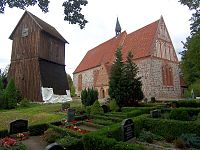Cammin village church
The village church of Cammin is a church of the Evangelical Lutheran parish of Cammin / Petschow in the municipality of Cammin in the Rostock district . The parish belongs to the Rostock provost in the Mecklenburg parish of the Evangelical Lutheran Church in Northern Germany ( Northern Church ).
history
In 1226 the village of Cammin was first mentioned in a document. The occasion was the donation of four Hufen to the Güstrow Collegiate Foundation by Heinrich Borwin III. The Sonnenkamp monastery as the landowner in Cammin also has a lifting caster from 1319 . The church consecrated to Saint Lawrence was named in a letter of indulgence from Avignon , which was given by Pope Innocent VI. was issued on December 20, 1357, first mentioned in a document. After that, the church should not have stood for long, because it complains about the lack of equipment. In the Middle Ages, Cammin belonged to the Archdeaconate of Rostock.
Building description
The church is designed as a rectangular building made of field stones, which are carved at the corners. Brick was only used for window reveals, portals and gables. The east gable is decorated with panels and two toothed friezes. The choir closes smoothly in the east and is covered by an eight-part vault. Its floor plan is almost square (12 × 12 meters). The nave is a little higher and about 24 meters long and 15 meters wide. The east wall of the choir is pierced by three ogival windows, in the nave there are two pairs of windows on both the south and north sides, which were later enlarged downwards. The sacristy is attached to the choir to the north and a vestibule to the south. On the roof there is a ridge turret with an unusable bell from Rickert de Monkehagen's workshop . The bell tower stands to the south in front of the church.
Furnishing
A special piece of equipment is a Gothic winged altar with carved figures, which shows a crucifixion scene in the middle part, the representation of the Trinity , below John the Baptist , above right Saint Laurentius, below Anna the three of us. The twelve apostles are depicted in the wings of the altar .
The baroque pulpit dates from 1732 and shows the figures of Salvator mundi and the four evangelists on the basket . The sound cover is crowned by a pelican as a symbol of the sacrificial death of Christ. Several tombstones of the Koss family can be found in the church.
organ
The organ was built from 1722 to 1724 by Hans Hantelmann on the north gallery. In 1853 the instrument was rearranged by Friedrich Wilhelm Winzer and moved to the west gallery. In 2003 the instrument was extensively restored by the Dresden organ builder Kristian Wegscheider . The original disposition of Hantelmann was largely restored or reconstructed; only the sub-bass remained. The organ now has 14 registers on the manual and pedal mechanism (slider drawer). The playing actions are mechanical
|
|
|||||||||||||||||||||||||||||||||||||||||||||||||||||||||||||||||||||||||||||
Remarks
See also
List of churches in the Rostock Provostry
Web links
- Literature about the village church Cammin in the state bibliography MV
- Friedrich Schlie : Art and historical monuments of Mecklenburg , 1899
- dorfkirchen-in-not.de
Individual evidence
- ^ Friedrich Schlie: Art and History Monuments of Mecklenburg , Volume 1, 1899, p. 447.
- ↑ Information on the Hantelmann organ
Coordinates: 53 ° 59 '23.4 " N , 12 ° 21' 20.9" E
